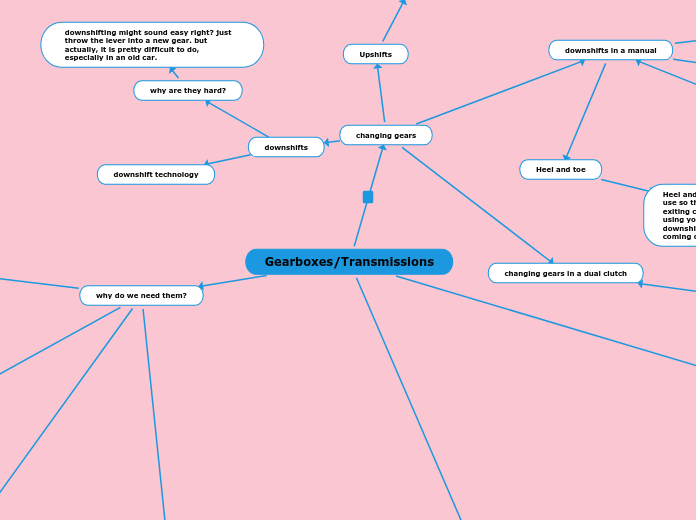Gearboxes/Transmissions
why do we need them?
gearboxes help make a car capable of going faster. without a gearbox, the wheels would only be able to turn as fast as the engine. with one, they can spin faster
without a gearbox, a car would be hard to start. the gearbox makes the engine turn more times than the wheels in low gears, which helps give it more torque. if this didn't happen, the car would get stuck more easily
Gearboxes also make cars more fuel efficient, because they can keep an engine going fast at low RPM
if cars didn't have gearboxes, the powertrain would get damaged faster. when the engine is trying to force the wheels to turn in too high of a gear, the crankshaft and transmission get put under a lot of stress. having lower gear reductions helps with this
fuel economy
why do gearboxes make cars more fuel efficient?
Different types of transmission systems
CVT (continuously variable transmission)
automatic transmission
Manual gearbox
torque converter automatic
sequential transmission
dual clutch transmission(DCT)
automated manual transmission
an automated manual transmission (AMT) is essentially a manual transmission with a robot holding the clutch and gear lever.
Advantages over standard automatic
disadvantages over automatic
comparisons to manual transmission systems
changing gears
changing gears in a dual clutch
downshifts in a manual
modern manual transmissions
Modern transmissions have more assists to help with downshifting so it's easier
older manual transmissions
Hard
Heel and toe
Heel and toe is a trick that racecar drivers use so that they are more efficient while exiting corners. if you hold the brake while using your heel and toe of your right foot to downshift, you can get into a lower gear for coming out of the corner
Upshifts
Upshifting helps increase the amount of power going to the wheels so that the car can go faster.
Gears
types of gears
how do they work
why are they hard?
downshifting might sound easy right? just throw the lever into a new gear. but actually, it is pretty difficult to do, especially in an old car.
downshift technology
downshifts
Why do engines make power?
Engines need air and fuel to make power. They suck these into the cylinders, which then explode them to push the pistons and generate power. The exhaust then goes out of the cylinder and the process repeats.
more info
making power in a standard, 4 stroke, engine(I don't want to talk about rotary or 2 stroke engines right now)
To make power, engines take gas and explode it to push a crankshaft. This is done in a few steps: 1. intake: the piston cycles around and starts coming to the top of the cylinder. a bit of fuel and air is then injected above the piston. 2. compression: when the piston starts coming further up the cylinder, the air and the fuel gets shoved together. 3. combustion: when the engine starts moving downward, the fuel and air mixture is exploded. the gas from this reaction then pushes the piston further down. 4. exhaust: the piston starts moving up again. some valves open and the gases from the explosion rapidly leave the cylinder, just before the intake and ignition start again.
To run at more revolutions per minute, engines need to suck in more air and fuel to keep the engine going faster.
Forced induction
different types of forced induction
turbocharging
How do they work?
supercharging
superchargers VS turbochargers
Supercharging VS natural aspiration
How do they work?
Superchargers take power off the crankshaft of a car and use it to force air into the engine.
